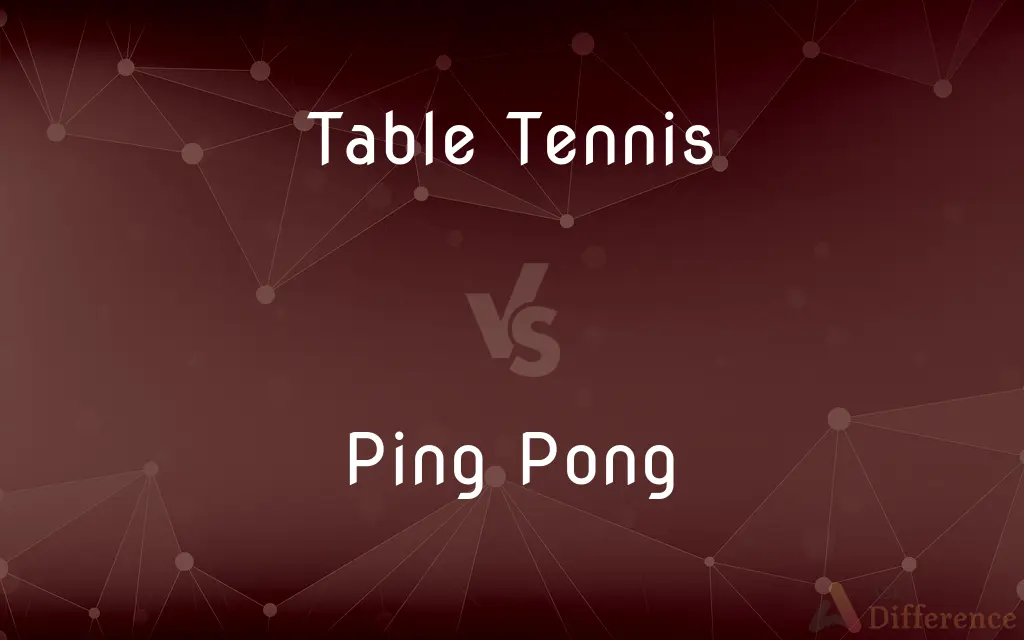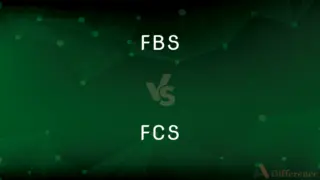Table Tennis vs. Ping Pong — What's the Difference?
By Fiza Rafique & Maham Liaqat — Published on March 5, 2024
Table Tennis is a competitive sport with strict rules governed by the International Table Tennis Federation (ITTF), while Ping Pong is often considered the recreational version of the game, played more casually and with fewer formalities.

Difference Between Table Tennis and Ping Pong
Table of Contents
ADVERTISEMENT
Key Differences
Table Tennis is recognized as a serious, competitive sport that adheres to standardized rules and equipment specifications set by the ITTF. This includes the type of paddles used, the ball's size and weight, and the playing environment. Ping Pong, although historically the same sport, has come to represent the more casual, social aspect of the game, where the emphasis is on fun and the equipment and playing conditions are less regulated.
The distinction also extends to the playing style and equipment. Competitive Table Tennis players use customized paddles covered with specialized rubber for varying spin and speed, adhering to ITTF standards. Ping Pong players often use pre-made paddles, which might not meet these competitive standards but are suitable for casual play. This difference highlights the sport's adaptability to both serious and leisurely contexts.
Tournaments and competitions further distinguish Table Tennis from Ping Pong. Table Tennis competitions, including the Olympics, feature highly skilled athletes and are governed by strict rules regarding gameplay, attire, and equipment. Conversely, Ping Pong tournaments are more likely to be local, less formal events that emphasize participation and enjoyment over competition.
Cultural perceptions also play a role in differentiating the two. In many circles, Table Tennis is viewed with a degree of professionalism and respect akin to other sports, requiring training, strategy, and physical fitness. Ping Pong, with its more relaxed approach, is seen as accessible to a wider audience, offering a social experience that can be enjoyed without extensive training or knowledge of the sport.
Despite these differences, the basic rules of play remain similar between Table Tennis and Ping Pong, including the scoring system, the table dimensions, and the objective of the game. This common ground ensures that enthusiasts of both versions can appreciate and participate in the sport, regardless of the level of formality.
ADVERTISEMENT
Comparison Chart
Governing Body
International Table Tennis Federation (ITTF)
No official governing body for casual play
Equipment Standards
Strict specifications for paddles, balls, and tables
Flexible, with more relaxed equipment standards
Playing Level
Competitive, with professional and amateur leagues
Recreational, often played socially or casually
Rules and Regulations
Adheres to ITTF rules, including serve, scoring, and attire
Rules are more flexible and adapted for casual play
Tournaments
Organized competitions with formal rankings
Informal tournaments, often without strict adherence to rules
Compare with Definitions
Table Tennis
A competitive racket sport with specific rules and equipment, governed by the ITTF.
She competes in national table tennis tournaments.
Ping Pong
The casual form of table tennis, often played for fun or socially.
We played ping pong at the family reunion.
Table Tennis
Requires skill, strategy, and physical fitness to play at a competitive level.
He trains daily to improve his table tennis serve.
Ping Pong
Equipment and playing conditions are less regulated.
Their ping pong paddles were old but worked fine for a casual game.
Table Tennis
Features organized competitions, including the Olympics.
Table tennis became an Olympic sport in 1988.
Ping Pong
Tournaments are more about participation than winning.
The local bar hosts a ping pong tournament every month.
Table Tennis
Played on a standard-sized table with specific net height and table dimensions.
The official table tennis table is 9 feet long.
Ping Pong
Can be played anywhere with enough space for a table.
They set up a ping pong table in the garage.
Table Tennis
Utilizes paddles with ITTF-approved rubber for controlling spin and speed.
His table tennis paddle is customized for offensive play.
Ping Pong
Rules are adaptable, focusing on enjoyment over strict competition.
In our ping pong games, we don't worry about official scoring.
Ping Pong
Alternative form of ping pong
Ping Pong
An indoor modification of lawn tennis played with small bats, or battledores, and a very light, hollow, celluloid ball, on a large table divided across the middle by a net. Also called table tennis.
Ping Pong
To play ping-pong.
Ping Pong
To bounce back and forth, in the manner of a ping-pong ball.
Ping Pong
A game (trade name Ping-Pong) resembling tennis but played on a table with paddles and a light hollow ball
Common Curiosities
Is Ping Pong different from Table Tennis?
Yes, Ping Pong is often seen as the recreational version of Table Tennis, with more relaxed rules and equipment standards.
Can Table Tennis and Ping Pong use the same equipment?
While they can use similar equipment, competitive Table Tennis has specific requirements for paddles and balls that Ping Pong does not necessarily follow.
Are the rules of Table Tennis the same as Ping Pong?
The basic rules of play are similar, but Table Tennis follows strict ITTF regulations, while Ping Pong rules are more flexible.
What equipment is essential for playing Table Tennis?
A regulation-size table, net, ITTF-approved balls, and paddles with specific rubber types are essential for competitive play.
Do you need special training to play Table Tennis?
Competitive Table Tennis players often undergo specialized training to improve their skills, strategy, and fitness, which is not as necessary for casual Ping Pong play.
Can you play Ping Pong competitively?
Yes, there are Ping Pong tournaments, but they are generally more informal and less regulated than Table Tennis competitions.
Is Table Tennis an Olympic sport?
Yes, Table Tennis has been an Olympic sport since 1988.
Can anyone play Ping Pong?
Yes, Ping Pong is accessible to people of all ages and skill levels, focusing on fun and social interaction.
How do you score in Table Tennis and Ping Pong?
Scoring is similar in both, with players earning points when their opponent fails to return the ball properly, but official Table Tennis matches have specific serving and scoring rules.
What makes Table Tennis a competitive sport?
The structured rules, organized competitions, and emphasis on skill and strategy elevate Table Tennis to a competitive sport level.
How do Table Tennis players serve the ball?
Players must follow ITTF rules for serving, including throwing the ball vertically at least 16 cm without imparting spin, which differs from the more relaxed serves in Ping Pong.
Can Table Tennis improve physical fitness?
Yes, it requires quick reflexes, agility, and endurance, making it an excellent way to improve physical fitness.
Why is Ping Pong popular at social events?
Its accessibility, minimal equipment requirements, and adaptable rules make Ping Pong a popular choice for entertainment and socializing.
How do I get started with Table Tennis?
Joining a club or taking lessons can provide a structured introduction to the sport, including learning the rules, techniques, and training methods.
What is the key to winning in Table Tennis?
Success in Table Tennis comes from a combination of skill, strategic play, and consistent practice.
Share Your Discovery

Previous Comparison
Trucking vs. Logistics
Next Comparison
FBS vs. FCSAuthor Spotlight
Written by
Fiza RafiqueFiza Rafique is a skilled content writer at AskDifference.com, where she meticulously refines and enhances written pieces. Drawing from her vast editorial expertise, Fiza ensures clarity, accuracy, and precision in every article. Passionate about language, she continually seeks to elevate the quality of content for readers worldwide.
Co-written by
Maham Liaqat















































